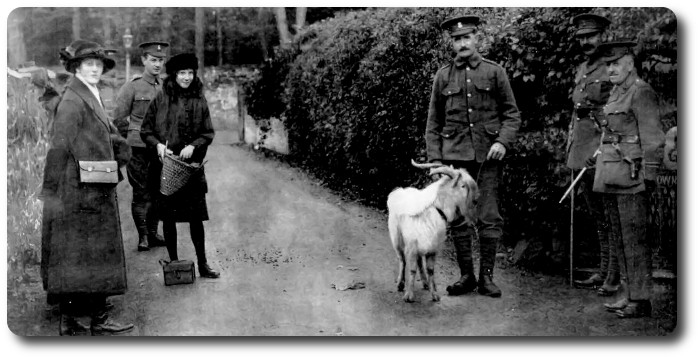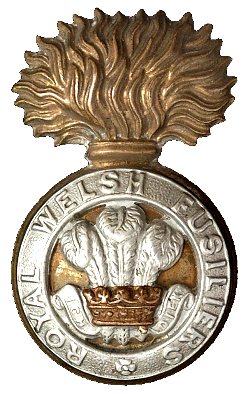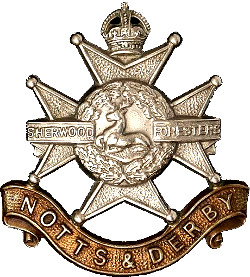Topic: Tradition

Regimental Goats and Rams
Regimental Mascots, by Major T.J. Edwards, M.B.E., F.R. Hist.S.
The Army Quarterly, Volume LXIII (October 1951 and January 1952)
 Possibly the most well-known animals of this kind are goats of The Royal Welch Fusiliers and The Welch Regiment. When on parade attired in their "full canonicals" they make a fine show. Their "full dress" consists of a handsome cloth embroidered with badges, etc., draped over the body, horns and hooves gilded and harness of high quality. They are led by goat-majors at the head of their units and lend a picturesque touch to ceremonial occasions. It is not known precisely when The Royal Welch Fusiliers had their first goat, but they certainly had one at the Battle of Bunker's Hill on the 17th of June, 1775, during the American War of Independence. It is not recorded whether his butting powers were put to any tactical use, but Major Donkin in his "Military Recollections and Remarks" has noted the following amusing incident:
Possibly the most well-known animals of this kind are goats of The Royal Welch Fusiliers and The Welch Regiment. When on parade attired in their "full canonicals" they make a fine show. Their "full dress" consists of a handsome cloth embroidered with badges, etc., draped over the body, horns and hooves gilded and harness of high quality. They are led by goat-majors at the head of their units and lend a picturesque touch to ceremonial occasions. It is not known precisely when The Royal Welch Fusiliers had their first goat, but they certainly had one at the Battle of Bunker's Hill on the 17th of June, 1775, during the American War of Independence. It is not recorded whether his butting powers were put to any tactical use, but Major Donkin in his "Military Recollections and Remarks" has noted the following amusing incident:
"Every 1st March, being the anniversary of their tutelar Saint, David, the officers give a splendid entertainment to all their Welch brethren; and after the cloth is taken away a bumper is filled round to H.R.H. the Prince of Wales (whose health is always drunk to first that day), the band playing the old tune of "The Noble Race of Shenkin," when a handsome drum-boy, elegantly dressed, mounted on the goat richly caparisoned for the occasion, is led thrice round the table in procession by the Drum Major. It happened in 1775, at Boston that the animal gave such a spring from the floor, that he dropped his rider upon the table, and then, bounding over the heads of some officers, he ran to the barracks with all his trappings to no small joy of the Garrison and populace."
This must have been a super-lusty goat for none of his successors appear to have given such a performance.
Queen Victoria appears to have liked the idea of this regiment having goats for in 1844 Her Majesty presented one to each of the two regular battalions, and all "replacements," for a considerable number of years afterwards, came from the Royal Herd at Windsor.
The Welch Regiment had a goat during the Afghan War, with which it marched into enemy territory, but died in the Bolan Pass in 1842. For many years these goats also came from the Royal Herd, but the early ones were gifts from distinguished personages, including the Duke of Wellington. During the South African War of 1899-1902 one was obtained in the theatre of operations for a pound of butter, which might be regarded as suitable exchange for a "butter."
In the matter of diet goats have a fairly catholic taste and hardly anything about barracks comes amiss. Even so they ought to exercise some discretion in what they eat. We remember one goat of pre-Great War vintage that celebrated Christmas Day by eating the paper decorations around a barrack room. Flour paste and tissue paper apparently have a habit of expanding considerably when "housed" together inside a goat. What the limit of expansion is we do not know, but we do know that this animal's interior had not the requisite elasticity—with fatal results.

Rex, the goat of The Welch Regiment, caused some embarrassment on Church Parade at Aldershot in November, 1932. Adorned in all his finery, he stood at the head of the battalion, but when the C.O. ordered "Quick March," Rex lay down and refused to budge. Neither persuasion nor threats could make him rise so he was dragged somewhat unceremoniously from the parade and placed "under arrest." His case was inquired into and it was found that the regular goat-major was on leave and Rex would take no orders from his deputy.
 Rams seem to have some affinity to goats if only in general appearance and the 2nd Bn. The Sherwood Foresters had rams as their mascots ever since the first one was captured from the enemy at Kotah during the Indian Mutiny. Now that the 2nd Bn. has been disbanded the 1st Bn. is continuing the custom. During an assault on the mutineers the O.C., Lieut.-Colonel Raines, noticed a fine ram tethered in a temple compound, so he remarked to Private Cody of the Grenadier Company, "Do you think you could capture that ram?" and Cody replied assuringly, "Yes, Sorr, I'm sure I could." "Right-o, go ahead," said the C.O., and handing his rifle to a nearby sergeant the Grenadier crept towards his prize. The regiment watched with anxiety as Cody slithered over low walls under fire from a hidden enemy but fortune favoured him and he reached the ram without being hit. He fussed the animal a little to gain its confidence and then returned to his unit, lifting the animal over the walls. When the rebels saw their "rations on the hoof" being taken from them they increased their fire, but although bullets spattered on the wa1ls around him, Cody was unscathed.
Rams seem to have some affinity to goats if only in general appearance and the 2nd Bn. The Sherwood Foresters had rams as their mascots ever since the first one was captured from the enemy at Kotah during the Indian Mutiny. Now that the 2nd Bn. has been disbanded the 1st Bn. is continuing the custom. During an assault on the mutineers the O.C., Lieut.-Colonel Raines, noticed a fine ram tethered in a temple compound, so he remarked to Private Cody of the Grenadier Company, "Do you think you could capture that ram?" and Cody replied assuringly, "Yes, Sorr, I'm sure I could." "Right-o, go ahead," said the C.O., and handing his rifle to a nearby sergeant the Grenadier crept towards his prize. The regiment watched with anxiety as Cody slithered over low walls under fire from a hidden enemy but fortune favoured him and he reached the ram without being hit. He fussed the animal a little to gain its confidence and then returned to his unit, lifting the animal over the walls. When the rebels saw their "rations on the hoof" being taken from them they increased their fire, but although bullets spattered on the wa1ls around him, Cody was unscathed.
The ram immediately became a firm favourite with all ranks and although he was originally intended "for the table" he was spared this fate and instead became the regimental mascot, being dubbed "Derby I," the old 95th Foot having had "Derbyshire" inc1uded in its official title in 1825. He proved to be the first of a long line for "Derby XVII" reigns at present [1952]. Derby I had a strong sense of ownership, and if any other ram came near the regiment he was "for it." Usually only one round was sufficient to settle any argument. The ladies of the regiment made him a beautiful scarlet coat and a plume for his brow: on the coat he wore the Indian Mutiny medal which has also been worn by all of his successors in the "appointment." Derby III was remarkable for the fact that he had two pairs of horns, the second pair curving towards the front, a few inches below his ears. He was the gift of the Maharajah of Kashmir. Derby VIII was a born atheist and strongly objected to attending Divine Service mainly, it is thought, because he did not like the music played by the band on church parade. He suffered from ingrowing horns which was incurable and he had to be "put away." The Regimental Magazine recorded his premature demise thus: "Deaths. At Solon on the tenth of October 1893, Derby VII. By the hand of a butcher." He became a hearthrug in his next reincarnation.

